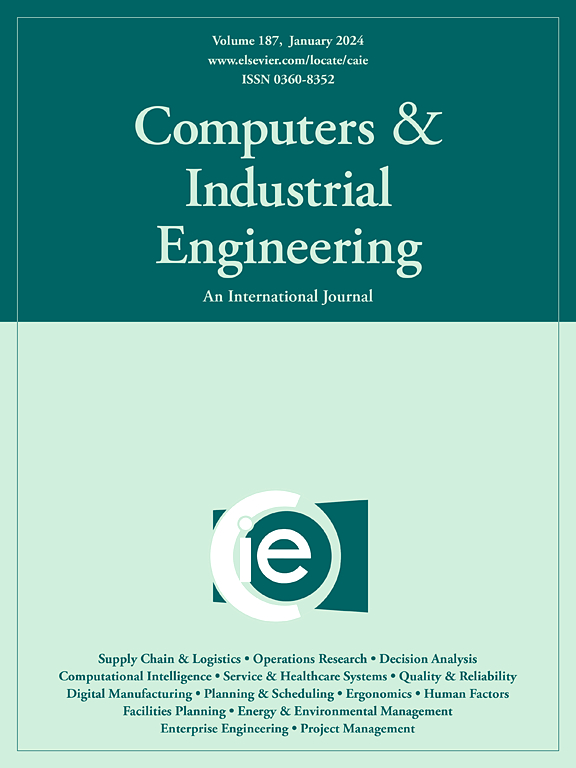A branch-and-cut algorithm for the integrated employee timetabling and hybrid job-shop scheduling problem with time lags and setup times
IF 6.5
1区 工程技术
Q1 COMPUTER SCIENCE, INTERDISCIPLINARY APPLICATIONS
引用次数: 0
Abstract
This paper addresses a real-world manufacturing scheduling problem that integrates employee timetabling with production scheduling. The employee timetabling problem considers skill requirements, employee availability, and legislative regulations. The production scheduling problem is modeled as a re-entrant hybrid job-shop, where jobs may revisit machines multiple times. The problem includes further complexities such as time lags, sequence-dependent setup times, and machine availability constraints. To address these challenges, a novel time period-based modeling approach is introduced. By discretizing the planning horizon into work periods, the proposed formulation ensures that each employee is assigned to a single machine per period, thereby reducing frequent transitions, improving workforce stability, and enhancing operational feasibility. Furthermore, we develop an enhanced decomposition and cut generation method, which goes beyond conventional single-cut strategies by applying multiple problem-specific cuts per iteration. These cuts are designed to exploit the hybrid structure and inherent symmetries of the problem, significantly refining the solution space and accelerating convergence. This approach is embedded within a newly developed Branch-and-Cut algorithm, leading to substantial gains in computational efficiency, especially for large-scale instances where classical MILP and CP methods underperform. Overall, the proposed formulation and algorithmic framework provide a scalable, efficient, and practically viable solution to complex integrated scheduling problems in hybrid job-shop environments.
具有时间滞后和装配时间的综合员工调度和混合作业车间调度问题的分支切断算法
本文解决了一个实际生产调度问题,该问题将员工调度与生产调度相结合。员工时间表问题考虑技能要求、员工可用性和立法规定。生产调度问题被建模为可重新进入的混合作业车间,其中作业可能多次访问机器。这个问题包括更多的复杂性,如时间滞后、序列相关的设置时间和机器可用性约束。为了解决这些挑战,介绍了一种新的基于时间段的建模方法。通过将计划范围离散到工作周期,所提出的公式确保每个员工在每个周期分配到一台机器,从而减少频繁的转换,提高劳动力稳定性,并增强操作可行性。此外,我们开发了一种增强的分解和切割生成方法,它超越了传统的单切割策略,通过在每次迭代中应用多个特定问题的切割。这些切割旨在利用问题的混合结构和固有对称性,显著地改进解空间并加速收敛。该方法嵌入到新开发的Branch-and-Cut算法中,大大提高了计算效率,特别是在经典MILP和CP方法表现不佳的大规模实例中。总体而言,所提出的公式和算法框架为混合作业车间环境下复杂的集成调度问题提供了一个可扩展、高效和实际可行的解决方案。
本文章由计算机程序翻译,如有差异,请以英文原文为准。
求助全文
约1分钟内获得全文
求助全文
来源期刊

Computers & Industrial Engineering
工程技术-工程:工业
CiteScore
12.70
自引率
12.70%
发文量
794
审稿时长
10.6 months
期刊介绍:
Computers & Industrial Engineering (CAIE) is dedicated to researchers, educators, and practitioners in industrial engineering and related fields. Pioneering the integration of computers in research, education, and practice, industrial engineering has evolved to make computers and electronic communication integral to its domain. CAIE publishes original contributions focusing on the development of novel computerized methodologies to address industrial engineering problems. It also highlights the applications of these methodologies to issues within the broader industrial engineering and associated communities. The journal actively encourages submissions that push the boundaries of fundamental theories and concepts in industrial engineering techniques.
 求助内容:
求助内容: 应助结果提醒方式:
应助结果提醒方式:


